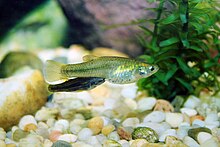
Gila topminnow

| Gila topminnow | |
|---|---|

| |
| Scientific classification | |
| Domain: | Eukaryota |
| Kingdom: | Animalia |
| Phylum: | Chordata |
| Class: | Actinopterygii |
| Order: | Cyprinodontiformes |
| Family: | Poeciliidae |
| Genus: | Poeciliopsis |
| Species: | P. occidentalis
|
| Binomial name | |
| Poeciliopsis occidentalis (S. F. Baird & Girard, 1853)
| |
| Synonyms[3] | |
|
Heterandria occidentalis S.F. Baird & Girard, 1853 | |
The Gila topminnow or charalito (Poeciliopsis occidentalis) is a species of fish in the family Poeciliidae. It is found in Mexico and the United States.

Description
The Gila topminnow has an elongated curved body. Males are rarely over 25 mm (0.98 in) and they are smaller than females, which can sometimes be 50 mm (2.0 in).[4] The belly is often white with darker body above, has scales with dark outlines, and a lateral dark band on the side.

Distribution

Gila topminnow once occupied in the Gila River drainage in Arizona, New Mexico, and Mexico. Currently, they are known to be in Gila River drainage in Arizona and Mexico, having been extirpated from New Mexico due to the introduction of Gambusia affinis.

Biology
Gila topminnow was once the most common fish found in the Gila River drainage. They are fertilized internally; reproduction season usually is from April to November. The female gives birth from 10–15 young per brood. These young brood will reach maturity from a weeks to several months. Gila topminnow are omnivorous, and eat food such as detritus and amphipod crustaceans; but feed mostly on aquatic insect larvae, especially mosquitos.

Habitat
This species of fish prefers to live in shallow warm water in headwater springs. They can survive in water with temperature ranging from near freezing to near 100 °F (38 °C). They can also live in water with a wide range of pH from 6.6 – 8.9 and salinity from fresh water to sea water.[5]

Conservation
Gila topminnow are endangered due to predation and competition from the introduced mosquitofish. Threats also come from continued habitat loss due to water development, habitat degradation due to erosion from roads and drought. Gila topminnow from Sharp Spring are currently being held and bred at Dexter National Fish Hatchery & Technology Center at Dexter, New Mexico, for re-introduction to wild habitats.[5]

References
- ^ Matamoros, W.A. (2020) [amended version of 2019 assessment]. "Poeciliopsis occidentalis". IUCN Red List of Threatened Species. 2020: e.T15350832A176961098. doi:10.2305/IUCN.UK.2020-3.RLTS.T15350832A176961098.en. Retrieved 16 November 2021.
- ^ "Poeciliopsis occidentalis". NatureServe Explorer. NatureServe. Retrieved 23 September 2024.
- ^ Froese, Rainer; Pauly, Daniel (eds.). "Poeciliopsis occidentalis". FishBase. August 2019 version.
- ^ Minckley, W.L. (1973). Fishes of Arizona. Phoenix: Arizona Game and Fish Department. pp. 199–202.
- ^ a b David A. Weedman (1998). "Gila topminnow, Poeciliopsis occidentalis occidentalis, Revised Recovery plan" (PDF). U.S. Fish and Wildlife Service, Region II.
- IUCN Red List least concern species
- NatureServe vulnerable species
- Poeciliopsis
- Fish of the Western United States
- Fauna of the Sonoran Desert
- Gila River
- Freshwater fish of the United States
- Near threatened fauna of North America
- Near threatened biota of Mexico
- ESA endangered species
- Taxa named by Spencer Fullerton Baird
- Taxa named by Charles Frédéric Girard
- Fish described in 1853
See what we do next...
OR
By submitting your email or phone number, you're giving mschf permission to send you email and/or recurring marketing texts. Data rates may apply. Text stop to cancel, help for help.
Success: You're subscribed now !


